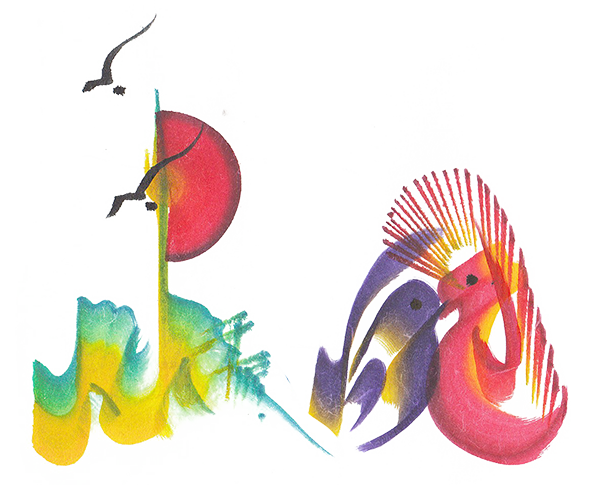SEE HERE : FINELY KNIT
Having firmly put to one side the age-old divide between “art” and “craft” (which, I would argue, is simply not real), in a community art gallery in West Wales I stood before a tremendous artwork. The trek through the gallery towards it was not unlike moving through the Accademia towards Michelangelo’s David - it appears first as a technicolour wink framed by the low doorway of the rear gallery in Pendre Arts in Cardigan, Wales, and it’s not until you’re in the room with it that you get a real sense of its size.
It’s not even the size of the cardigan that is most impressive (though at five metres in length, it is enormous). “There’s a big cardigan,” our hosts, the woman in the post office, the waiter said, “that’s worth a look.” The banality of literalness lets you down sometimes, and in this case I had expected just a large, cream-coloured cardigan.
In fact, this cardigan is a tome. It is map, too. The laminated page sitting on a coffee table in front of it adds that it was made “by the people of Cardigan, to celebrate 900 years of the town’s heritage.” Truly, this didn’t seem enough. A bit more research uncovered that the project was coordinated by artist and graphic designer Lisa Hellier, who loves maps. She secured a grant from the Heritage Lottery Fund and lead the project alongside Susan McComb, a textile artist who she studied with in Glasgow. Together they invited more than 300 people to contribute, including local schoolchildren, whose faces are knitted into the inside of the cardigan.
There was no ability requirement to knit, no age requirement either. People sent pieces in from abroad. The brief was simply the town itself, with a caveat to encourage cable stitch where possible, because “the plaited wool was reminiscent of the ropes of Cardigan’s shipping heritage”. The knitters knitted together as well, old and young, and listened to talks about the history of the town while they worked. Nine months it took in total to knit the components, and six more weeks to sew the monster together.
In 1973 Marcel Duchamp counselled that "art is not about itself but the attention we bring to it." On what planet is this craft not art? During the Pinochet regime in Chile in the 1970s, women altered their traditionally pastoral arpilleras (literally “burlap”, a kind of scenic tapestry) to include the scenes of torture and murder their loved ones, the desaparecidos (“disappeared”), were enduring at the hands of the military regime. The unlikely medium of protest protected the arpilleristas (for the most part), where photographers, for example, were targeted outright. That art sits among the most poignant of the century.
If we come back to Wales, though, and to the cardigan, there is no violence. There are mermaids with sequins in their tails, castles with knights, and pubs with flower boxes. There are seagulls deftly knitted to look like they’re flying, and the 15th century bridge into town is kitted in three how-did-they-do-it dimensions. I am in awe of it, and as my mother, a knitter herself, explains the stitches to me, I realise I love it more than I could ever love Michelangelo’s giant.
The cardigan, at last, will be on tour this autumn in England, Scotland and Northern Ireland.
SEE HERE is a monthly musing on a single artwork from anywhere, written by Amy Stewart: @A_L_STEWED // ASTEWARTWRITING.COM.







